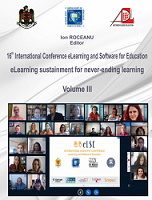THE USE OF THE COMMUNICATIVE APPROACH AND NEW TECHNOLOGIES DURING A VOCABULARY AND GRAMMAR PRACTICAL COURSE. STUDENTS’ PERCEPTION AND INPUT
THE USE OF THE COMMUNICATIVE APPROACH AND NEW TECHNOLOGIES DURING A VOCABULARY AND GRAMMAR PRACTICAL COURSE. STUDENTS’ PERCEPTION AND INPUT
Author(s): Alexandra CotocSubject(s): Foreign languages learning, Applied Linguistics, Higher Education , Distance learning / e-learning
Published by: Carol I National Defence University Publishing House
Keywords: communicative approach; new technologies; English vocabulary; grammar;
Summary/Abstract: Today’s warp-speed world and new technologies have shaped our students and their learning behavior. As such, they are motivated by relevant, up-to-date, interactive classes that contain collaboration and digital devices. In this context, the use of the communicative approach and the blend of offline and online activities are fundamental in creating and maintaining efficient teaching strategies and methods. Our study focuses on the integration of these two elements in an English Vocabulary and Grammar practical course given to first year students majoring in English at the Faculty of Letters. The first part of the study will focus on the presentation of the specificity of the course: targeted group, duration, content and requirements, the students’ personal and professional profile and the teacher’s role. The second part of the article will introduce some useful digital tools and offline and online practices that we used with our students, providing some concrete examples and samples produced by the students during classroom activities. The last part of the article will give an insight into our students’ perception, feedback and input at the end of the course. Our study analyses the design of a practical course and the students’ perspective on it with the aim of tailoring and adjusting the educational context to suit our students’ needs and expectations and also to improve our students’ language skills and academic performance. Moreover, we also aim at producing autonomous learners and develop transferable skills that our students can use not only in other courses and seminars, but also in their future profession as language and communication specialists.
Journal: Conference proceedings of »eLearning and Software for Education« (eLSE)
- Issue Year: 16/2020
- Issue No: 03
- Page Range: 445-450
- Page Count: 6
- Language: English

